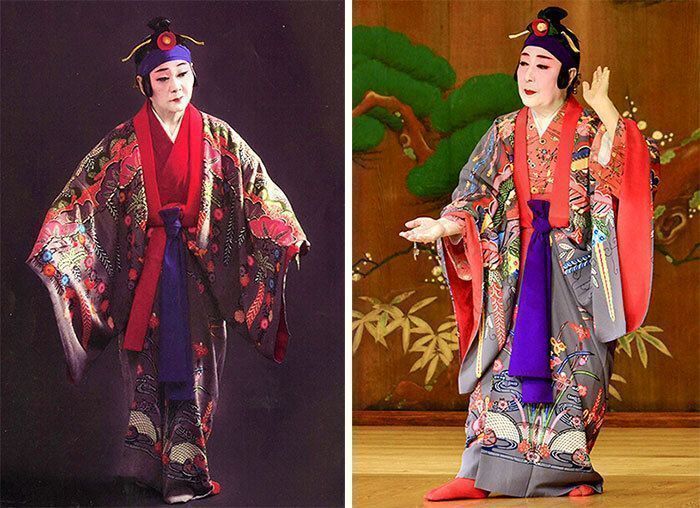Yukiko Miyagi and Fusako Shida become the first living national treasures in Ryukyu Buyo

Yukiko Miyagi (left, courtesy of Yukiko Miyagi) and Fusako Shida (right, courtesy of the Choyo-ryu school of Ryukyu dance) dancing the classic onna-odori “Shudun”
July 16, 2021 Ryukyu Shimpo
On July 16, the Japanese government’s Council for Cultural Affairs, chaired by Makoto Sato, provided Koichi Hagiuda, the Minister of Education, Culture, Sports, Science, and Technology (MEXT) with its selection for the next national living treasures. Nago-City native and current resident of Tsuji, Naha City, Yukiko Miyagi, 87, of the Shinyo-ryu school of Ryukyu traditional dance (Ryukyu Buyo), and Naha-City native and current resident of Nerima, Tokyo, Fusako Shida, 84, of the Choyo-ryu school of Ryukyu traditional dance, were chosen to be designated holders of nationally designated important intangible cultural properties (also known as national living treasures). It is the first time a living national treasure has been recognized in the field of Ryukyu dance and the first time a woman has been selected in the field of Ryukyu performing arts.
[Photos and Video] A Young Artist’s Mature Performance
https://ryukyushimpo.jp/photo/entry-1356421.html
So far, Okinawa has had 13 living national treasures, four of which have deceased. Eight are in the field of performing arts, with six of them actively performing in Okinawa: Choichi Terukina and Ichio Nakamura for Ryukyu Classical Music, (individual recognitions); Tokutaro Shiroma and Kishun Nishie for Kumiodori Sanshin (three-stringed instrument); Noho Miyagi for Kumiodori Tachikata; and Satoshi Higa for Kumiodori Taiko (drums).
Ryukyu dance is roughly divided into koten, or classical dance, which depicts the lives of the warrior class during the period of the Shuri Royal Government, and zou-odori, or miscellaneous dance, which depicts the lives of ordinary people after the Meiji period. During the Shuri Royal Government era, Ryukyu dance was performed by the Ryukyu warrior class on the ukanshin-udoui stage to welcome envoys from China. In the post-Meiji era, Ryukyu dance became a form of entertainment for the common people. The tachikata is mainly performed to the accompaniment of a singing sanshin to express the scenes in the songs and the emotions of the characters.
The Council for Cultural Affairs commented on Yukiko Miyagi as someone who “occupies an important position as a dancer who exceedingly embodies the traditional performance techniques of Ryukyu dance and possesses outstanding skills,” while “working to train and educate successors.” The Council noted that Fusako Shida embodies traditional performance techniques, and she has “demonstrated outstanding mastery of a wide range of Ryukyu dance, from classical koten dance to the miscellaneous zou-odori dance,” while striving to develop and pass down traditional Ryukyu dance.
Living national treasures are officially named in the kanpo, the official gazette of the Japanese government, in September or October. As of July 1, Okinawa has 9 active living national treasures, the third largest in Japan after Tokyo at 45 and Kyoto, 12, along with Ishikawa, 9.
◆Brief biography
Yukiko Miyagi was born in 1933 in Haneji Village, Kunigami County (current day Nago City). She began studying under Ryukyu dancer Yoshiko Majikina in 1951, opened the Yukiko Miyagi Ryukyu Dance Dojo in 1968 and received a master’s license from Majikina in 1974. In 1996, she was designated holder of the prefectural intangible cultural asset, Okinawan Traditional Dance. In 1999, She became chair of the Yoshiyuki Shinyo-ryu school of dance. In 2009, she was designated a holder of the important intangible cultural property, Ryukyu Buyo (general recognition). Okinawa Prefecture honored her as a Person of Cultural Merit in 2003, and a Person of Merit in 2019.
Fusako Shida was born in Naha City in 1937. She began studying under Ryukyu dancer Seijyu Tamagusuku in 1940 and received her master’s license from Tamagusuku in 1955. She founded a dance institute in 1956. In 1965, she received a license from Koyu Shimabukuro. In 1991, she was awarded the Minister of Education, Culture, Sports, Science and Technology’s Art Encouragement Prize. She was designated a holder of the prefectural intangible cultural property, Okinawa Traditional Dance, in 1996 and became the holder of the important intangible cultural property Ryukyu Dance (general recognition) in 2009. She was honored as a Person of Cultural Merit in 2004 and has led the Choyo-ryu school of dance since 2007.
◆What is a Living National Treasure?
A living national treasure is an individual who has been recognized by the national government under the Law for the Protection of Cultural Properties as a person who has highly embodied and mastered the performing arts or craft techniques designated as important intangible cultural properties. Once a year, the experts of the Council for Cultural Affairs recommend individuals and the Minister of Education, Culture, Sports, Science, and Technology makes the official designation. The designation expires upon the holder’s death.
(English translation by T&CT and Monica Shingaki)
Previous Article:Why does rapper Bad Bunny’s song Yonaguni have over 200 million views? Yonaguni town hall officials wonder
Next Article:Naha’s new Cultural Arts Theater incorporates elements of Shuri traditional textiles and the Okinawan Sea, and hopes to become a beacon for arts and culture
[Similar Articles]
- Nishie designated a Living National Treasure for Kumi Odori Ongaku-uta Sanshin
- Ichio Nakamura celebrates Living National Treasure designation with concert
- Living National Treasure Noho Miyagi first Okinawan to win Japan Art Academy Prize
- National Theatre Okinawa celebrates 10th anniversary of its opening
- Important Intangible Cultural Property certification holders and Living National Treasures perform together for a brighter future
 Webcam(Kokusai Street)
Webcam(Kokusai Street)


